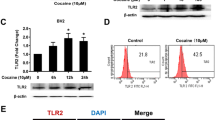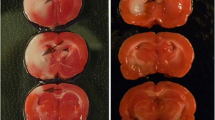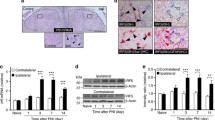Abstract
The cytokine tumor necrosis factor alpha (TNFα) is a key factor in several inflammatory diseases and its levels increase in response to a variety of internal or external stimuli. The regulation of the TNFα promoter is mediated by several transcription factors including the nuclear factor kappa B protein (NF-κB). This study examines the role of NF-κB in the regulation of TNFα production by morphine in microglia. Using reverse transcriptase polymerase chain reaction, we demonstrated the presence of morphine receptors in these cells. We next demonstrated the ability of morphine to promote TNFα production and secretion by these cells using a cytokine array assay. Transient transfection experiments led to the identification of the region located between nucleotides −751 and −615 within the TNFα promoter as being responsive to morphine treatment. The DNA sequence of this region contains a motif indicative of a potential NF-κB binding site. The use of a small interfering RNA directed against p65, a subunit of NF-κB, demonstrated that TNFα induction by morphine is NF-κB-dependent. All of the effects of morphine were reversed by the morphine inhibitor, naloxone. These data provide important insights into the effects of morphine on microglia.




Similar content being viewed by others
References
Ammon S, Mayer P, Riechert U, Tischmeyer H, Höllt V (2003) Microarray analysis of genes expressed in the frontal cortex of rats chronically treated with morphine and after naloxone precipitated withdrawal. Brain Res Mol Brain Res 112:113–125. doi:10.1016/S0169-328X(03)00057-3
Ammon-Treiber S, Höllt V (2005) Morphine-induced changes of gene expression in the brain. Addict Biol 10:81–89. doi:10.1080/13556210412331308994
Aneja R, Odoms K, Dunsmore K, Shanley TP, Wong HR (2006) Extracellular heat shock protein-70 induces endotoxin tolerance in THP-1 cells. J Immunol 177:7184–7192
Baud V, Karin M (2001) Signal transduction by tumor necrosis factor and its relatives. Trends Cell Biol 11:372–377. doi:10.1016/S0962-8924(01)02064-5
Bezzi P, Domercq M, Brambilla L, Galli R, Schols D, De Clercq E, Vescovi A, Bagetta G, Kollias G, Meldolesi J, Volterra A (2001) CXCR4-activated astrocyte glutamate release via TNFalpha: amplification by microglia triggers neurotoxicity. Nat Neurosci 4:702–710. doi:10.1038/89490
Bhat RS, Bhaskaran M, Mongia A, Hitosugi N, Singhal PC (2004) Morphine-induced macrophage apoptosis: oxidative stress and strategies for modulation. J Leukoc Biol 75:1131–1138. doi:10.1189/jlb.1203639
Brabers NA, Nottet HS (2006) Role of the pro-inflammatory cytokines TNFalpha and IL-1beta in HIV-associated dementia. Eur J Clin Invest 36:447–458. doi:10.1111/j.1365-2362.2006.01657.x
Bussiere JL, Adler MW, Rogers TJ, Eisenstein TK (1993) Cytokine reversal of morphine-induced suppression of the antibody response. J Pharmacol Exp Ther 264:591–597
Cole R, de Vellis J (1997) Astrocyte and oligodendrocyte cultures. In: Fedoroff S, Richardson A (eds) Protocols for neural cell culture. Humana, Totowa, NJ
Davis RL, Buck DJ, Saffarian N, Stevens CW (2007) The opioid antagonist, beta-funaltrexamine, inhibits chemokine expression in human astroglial cells. J Neuroimmunol 186:141–149. doi:10.1016/j.jneuroim.2007.03.021
Downward J (1998) Ras signalling and apoptosis. Curr Opin Genet Dev 8:49–54. doi:10.1016/S0959-437X(98)80061-0
El-Hage N, Wu G, Ambati J, Bruce-Keller AJ, Knapp PE, Hauser KF (2006a) CCR2 mediates increases in glial activation caused by exposure to HIV-1 Tat and opiates. J Neuroimmunol 178:9–16. doi:10.1016/j.jneuroim.2006.05.027
El-Hage N, Wu G, Wang J, Ambati J, Knapp PE, Reed JL, Bruce-Keller AJ, Hauser KF (2006b) HIV-1 Tat and opiate-induced changes in astrocytes promote chemotaxis of microglia through the expression of MCP-1 and alternative chemokines. Glia 53:132–146. doi:10.1002/glia.20262
El-Hage N, Bruce-Keller AJ, Knapp PE, Hauser KF (2008) CCL5/RANTES gene deletion attenuates opioid-induced increases in glial CCL2/MCP-1 immunoreactivity and activation in HIV-1 Tat-exposed mice. J Neuroimmune Pharmacol 3(4):275–285
Fiorillo CD, Williams JT (1996) Opioid desensitization: interactions with G-protein-coupled receptors in the locus coeruleus. J Neurosci 16:1479–1485
Glezer I, Munhoz CD, Kawamoto EM, Marcourakis T, Avellar MC, Scavone C (2003) MK-801 and 7-Ni attenuate the activation of brain NF-kappa B induced by LPS. Neuropharmacology 45:1120–1129. doi:10.1016/S0028-3908(03)00279-X
Gurwell JA, Nath A, Sun Q, Zhang J, Martin KM, Chen Y, Hauser KF (2001) Synergistic neurotoxicity of opioids and human immunodeficiency virus-1 Tat protein in striatal neurons in vitro. Neuroscience 102:555–563. doi:10.1016/S0306-4522(00)00461-9
Han Y, He T, Huang DR, Pardo CA, Ransohoff RM (2001) TNF alpha mediates SDF-1 alpha-induced NF-kappa B activation and cytotoxic effects in primary astrocytes. J Clin Invest 108:425–435
Haughey NJ, Nath A, Mattson MP, Slevin JT, Geiger JD (2001) HIV-1 Tat through phosphorylation of NMDA receptors potentiates glutamate excitotoxicity. J Neurochem 78:457–467. doi:10.1046/j.1471-4159.2001.00396.x
Hauser KF, El-Hage N, Stiene-Martin A, Maragos WF, Nath A, Persidsky Y, Volsky DJ, Knapp PE (2006) HIV-1 neuropathogenesis: glial mechanisms revealed through substance abuse. J Neurochem 100:567–586. doi:10.1111/j.1471-4159.2006.04227.x
Hayden MS, West AP, Ghosh S (2006) NF-κB and the immune response. Oncogene 25:6758–6780. doi:10.1038/sj.onc.1209943
Ho WZ, Guo CJ, Yuan CS, Douglas SD, Moss J (2003) Methylnaltrexone antagonizes opioid-mediated enhancement of HIV infection of human blood mononuclear phagocytes. J Pharmacol Exp Ther 307:1158–1162. doi:10.1124/jpet.103.056697
Hu S, Sheng WS, Lokensgard JR, Peterson PK (2005) Morphine potentiates HIV-1 gp120-induced neuronal apoptosis. J Infect Dis 191:886–889. doi:10.1086/427830
Ichijo H, Nishida E, Irie K, ten Dijke P, Saitoh M, Moriguchi T, Takagi M, Matsumoto K, Miyazono K, Gotoh Y (1997) Induction of apoptosis by ASK1, a mammalian MAPKKK that activates SAPK/JNK and p38 signaling pathways. Science 275:90–94. doi:10.1126/science.275.5296.90
Kieffer BL (1995) Recent advances in molecular recognition and signal transduction of active peptides: Receptors for opioid peptides. Cell Mol Neurobiol 15:615–635. doi:10.1007/BF02071128
Kriegler M, Perez C, DeFay K, Albert I, Lu SD (1988) A novel form of TNF/cachectin is a cell surface cytotoxic transmembrane protein: ramifications for the complex physiology of TNF. Cell 53:45–53. doi:10.1016/0092-8674(88)90486-2
Lim YJ, Zheng S, Zuo Z (2004) Morphine preconditions Purkinje cells against cell death under in vitro simulated ischemia–reperfusion conditions. Anesthesiology 100:562–568. doi:10.1097/00000542-200403000-00015
Locksley RM, Killeen N, Lenardo MJ (2001) The TNF and TNF receptor superfamilies: integrating mammalian biology. Cell 104:487–501. doi:10.1016/S0092-8674(01)00237-9
Minagar A, Commins D, Alexander JS, Hoque R, Chiappelli F, Singer EJ, Nikbin B, Shapshak P (2008) NeuroAIDS: characteristics and diagnosis of the neurological complications of AIDS. Mol Diagn Ther 12:25–43
Muller WE, Dobmeyer JM, Dobmeyer TS, Pergande G, Perovic S, Leuck J, Rossol R (1997) Flupirtine protects both neuronal cells and lymphocytes against induced apoptosis in vitro: implications for treatment of AIDS patients. Cell Death Differ 4:51–58. doi:10.1038/sj.cdd.4400206
Nottet HS, Persidsky Y, Sasseville VG, Nukuna AN, Bock P, Zhai QH, Sharer LR, McComb RD, Swindells S, Soderland C, Gendelman HE (1996) Mechanisms for the transendothelial migration of HIV-1-infected monocytes into brain. J Immunol 156:1284–1295
Nottet HS (2005) The blood brain barrier: monocyte and viral entry into the brain. In: Gendelman HE, Grant I, Everall IP, Lipton SA, Swindells S (eds) The neurology of AIDS. 2nd edn. Oxford University Press, Oxford, UK, pp 155–161
Patel JP, Sengupta R, Bardi G, Khan MZ, Mullen-Przeworski A, Meucci O (2006) Modulation of neuronal CXCR4 by the micro-opioid agonist DAMGO. J Neurovirol 12:492–500. doi:10.1080/13550280601064798
Peng H, Erdmann N, Whitney N, Dou H, Gorantla S, Gendelman HE, Ghorpade A, Zheng J (2006) HIV-1-infected and/or immune activated macrophages regulate astrocyte SDF-1 production through IL-1beta. Glia 54:619–629. doi:10.1002/glia.20409
Peterson PK, Sharp B, Gekker G, Brummitt C, Keane WF (1987) Opioid-mediated suppression of interferon-gamma production by cultured peripheral blood mononuclear cells. J Clin Invest 80:824–831. doi:10.1172/JCI113140
Probert L, Akassoglou K, Pasparakis M, Kontogeorgos G, Kollias G (1995) Spontaneous inflammatory demyelinating disease in transgenic mice showing central nervous system-specific expression of tumor necrosis factor alpha. Proc Natl Acad Sci U S A 92:11294–11298. doi:10.1073/pnas.92.24.11294
Rojavin M, Szabo I, Bussiere JL, Rogers TJ, Adler MW, Eisenstein TK (1993) Morphine treatment in vitro or in vivo decreases phagocytic functions of murine macrophages. Life Sci 53:997–1006. doi:10.1016/0024-3205(93)90122-J
Roy S, Cain KC, Chapin RB, Charboneau RG, Barke RA (1998) Morphine Modulates NFkB Activation in Macrophages. Biochem Biophys Res Commun 245:392–396. doi:10.1006/bbrc.1998.8415
Sawaya BE, Thatikunta P, Denisova L, Brady J, Khalili K, Amini S (1998) Regulation of TNFalpha and TGFbeta-1 gene transcription by HIV-1 Tat in CNS cells. J Neuroimmunol 87:33–42. doi:10.1016/S0165-5728(98)00044-7
Takashiba S, Shapira L, Amar S, Van Dyke TE (1993) Cloning and characterization of human TNF alpha promoter region. Gene 131:307–308. doi:10.1016/0378-1119(93)90314-S
Thomas DM, Kuhn DM (2005) MK-801 and dextromethorphan block microglial activation and protect against methamphetamine-induced neurotoxicity. Brain Res 1050:190–198. doi:10.1016/j.brainres.2005.05.049
Verma IM, Stevenson JK, Schwarz EM, Van Antwerp D, Miyamoto S (1995) Rel/NF-kappa B/I kappa B family: intimate tales of association and dissociation. Genes Dev 9:2723–2735. doi:10.1101/gad.9.22.2723
Williams MA, Turchan J, Lu Y, Nath A, Drachman DB (2005) Protection of human cerebral neurons from neurodegenerative insults by gene delivery of soluble tumor necrosis factor p75 receptor. Exp Brain Res 165:383–391. doi:10.1007/s00221-005-2307-9
Winzen R, Kracht M, Ritter B, Wilhelm A, Chen CY, Shyu AB, Müller M, Gaestel M, Resch K, Holtmann H (1999) The p38 MAP kinase pathway signals for cytokine-induced mRNA stabilization via MAP kinase-activated protein kinase 2 and an AU-rich region-targeted mechanism. EMBO J 18:4969–4980. doi:10.1093/emboj/18.18.4969
Wybran J, Appelboom T, Famaey JP, Govaerts A (1979) Suggestive evidence for receptors for morphine and methionine–enkephalin on normal human blood T lymphocytes. J Immunol 123:1068–1070
Yong VW, Antel JP (1997) Culture of glial cells from human brain biopsies. In: Fedoroff S, Richardson A (eds) Protocols for neural cell culture. Humana, Totowa, NJ
Yuasa T, Ohno S, Kehrl JH, Kyriakis JM (1998) Tumor necrosis factor signaling to stress-activated protein kinase (SAPK)/Jun NH2-terminal kinase (JNK) and p38. Germinal center kinase couples TRAF2 to mitogen-activated protein kinase/ERK kinase kinase 1 and SAPK while receptor interacting protein associates with a mitogen- activated protein kinase kinase kinase upstream of MKK6 and p38. J Biol Chem 273:22681–22692. doi:10.1074/jbc.273.35.22681
Zollner C, Stein C (2007) Opioids. Handb Exp Pharmacol 177:31–63. doi:10.1007/978-3-540-33823-9_2
Acknowledgments
The authors wish to thank past and present members of the Department of Neuroscience and Center for Neurovirology for their support and sharing of reagents and ideas. We also thank Dr. Martyn White for his comments and editorial assistance on the manuscript. This work was supported by grants awarded by NIH to BES and KK.
Author information
Authors and Affiliations
Corresponding authors
Rights and permissions
About this article
Cite this article
Sawaya, B.E., Deshmane, S.L., Mukerjee, R. et al. TNF Alpha Production in Morphine-Treated Human Neural Cells Is NF-κB-Dependent. J Neuroimmune Pharmacol 4, 140–149 (2009). https://doi.org/10.1007/s11481-008-9137-z
Received:
Accepted:
Published:
Issue Date:
DOI: https://doi.org/10.1007/s11481-008-9137-z




